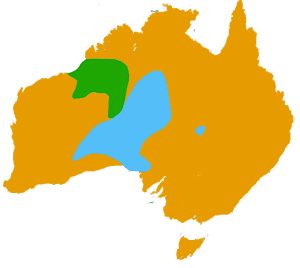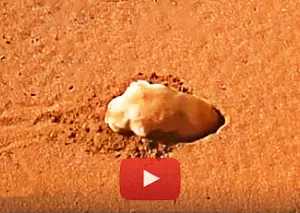
Photo: Rare photo of Marsupial Mole above ground
Contents
The marsupial mole, also known as an Itjaritjari, is a small, sausage-shaped Australian mammal that lives underground in the desert regions of Outback Australia. This small creature is equipped with specialized digging claws on its forelimbs for burrowing through the sand, allowing it to essentially 'swim' through the sand. Despite its name, it's not closely related to true moles but belongs to a distinct family of marsupials.
Marsupial Mole Characteristics Description of a Marsupial Mole

Photo: Marsupial Mole Face and front Legs
The marsupial moles have short, dense fur that varies in colour from white to pinkish-cinnamon to golden-red, depending on the sand they live in. They are approximately 10-20cm long, weigh 30-70gm, and have a tiny 2-2.5cm tail. They have very short stumpy legs with five toes on each foot. Their head is cone-shaped and featureless, with blind vestigial eyes hidden under their fur. They have tiny ear holes also hidden by their fur that are highly sensitive to low-frequency sounds. Their nose, which also acts as a shield and shovel while they dig, has small slit-like nostrils protected by hard callused skin. The third and fourth toes of their front feet are enlarged and have triangular, spade-like claws used to excavate soil in front of them. The first and second toes have small claws opposite the third and fourth toes, allowing the animal to grasp its prey. Their rear feet are flattened and slightly webbed, with the middle three digits possessing small claws. They use their hind feet to push soil behind them. They have a tiny, bald, leathery tail with a hard knob at the end. The male and female marsupial moles are similar in appearance, except that the female has a larger backward-facing pouch with two teats. The male also has a pouch in which it stores its testicles. There are two species of marsupial moles, Notoryctes typhlops and N. caurinus, in the Australian Outback. Its Aboriginal name is Itjaritjari.
Marsupial Mole Sand-Swimming How the Marsupial Mole Moves Underground

Unlike most other burrowing animals, the marsupial mole doesn't dig out hollow tunnels through which it travels. Instead, it "swims" through the sand, like a human swimming underwater, displacing the sand in front of it as it slowly nudges itself forward a few centimetres at a time.
The marsupial mole uses its spade-like front limbs to scope out sand in front of it and nudges its nose into the excavated space. It then pushes this sand under its body, where its rear limbs push the excavated sand behind it. This scoping and push action slowly propels the animal through the sand without creating a noticeable tunnel behind it. As the animal moves, sand behind it caves in, filling up its path through the sand.
The marsupial mole rarely wanders aboveground and only for a very short distance. It moves itself on the surface using a similar swimming motion it uses underground.
Marsupial Mole Habitat Where Do Marsupial Moles Live?

Photo: Marsupial Mole Distribution Map
The southern marsupial mole is found in the western central deserts of Australia at the intersection of South Australia, Northern Territory and Western Australia (coloured blue on the map). The northern marsupial mole lives in the north-western parts of Western Australia (coloured green on the map).
Marsupial moles live in areas with soft sandy dunes, sand-plains and sandy soils along river flats where shrubs and grasses such as spinifex are present. They spend almost their entire life underground, typically 20-100 cm below the surface. They require sufficiently large areas with these conditions in order to burrow freely through the soil. Marsupial moles are solitary animals and travel underground individually. There is no evidence of large or permanent burrows where more than one individual might congregate.
Marsupial Mole Diet What Does the Marsupial Mole Eat?
Marsupial moles are omnivores and feed on invertebrates, ant eggs, insect pupae and larvae, centipedes, beetles, small salamanders and lizards. It also eats seeds and vegetable matter. Given its preference to remain and feed underground, it has been suggested that it prefers insect eggs, larvae and pupae deposited underground.
The exact way in which marsupial moles search for food is unknown. However, given their excellent sense of smell and hearing, it has been suggested that these are the primary senses they use for searching for food.
Marsupial Mole Reproduction Marsupial Mole Babies
There is very little information about marsupial moles' mating and reproductive behaviour. However, breeding is believed to take place around November, when one or two offspring are born. Like all other marsupials, marsupial moles give birth to underdeveloped young that find their way to their mother's pouch, where they attach themselves to a nipple and grow into viable offspring.
Marsupial Mole - What We Don't Know Lots of Things We Don't Know
There are many things we do not know for sure about the marsupial mole. These include
• How they detect their food.
• How they mate, how many babies they have per litter and how often they mate.
• What times of the day they are active.
• If they build permanent burrows.
• Their social behaviour is not known but it is thought that they are solitary animals.
Marsupial Mole Predators and Threats Is the Marsupial Mole Endangered?
Marsupial moles were rarely hunted by the native aborigines and were quite common until the early 20th century. However, during the early 20th century, marsupial moles were hunted for their pelts. Several hundred of thousand were killed during this time, and the sighting of these animals became more and more infrequent.
While well protected underground, when on the surface the marsupial moles falls prey to introduced animals such as the feral cats and foxes, dingoes, native birds of prey and snakes.
There is no direct evidence of the status of the marsupial mole population in the wild. It is thought, however, that their are in decline. For this reason the marsupial mole is classified in the ICUN Red List as threatened and the Australian government lists it as endangered.
